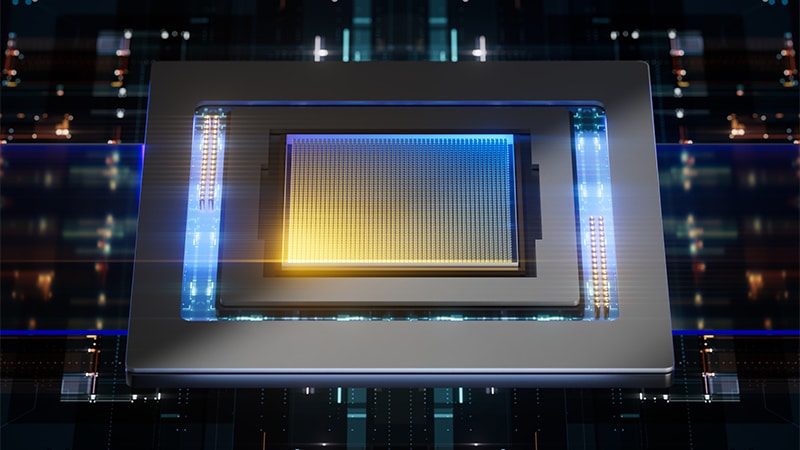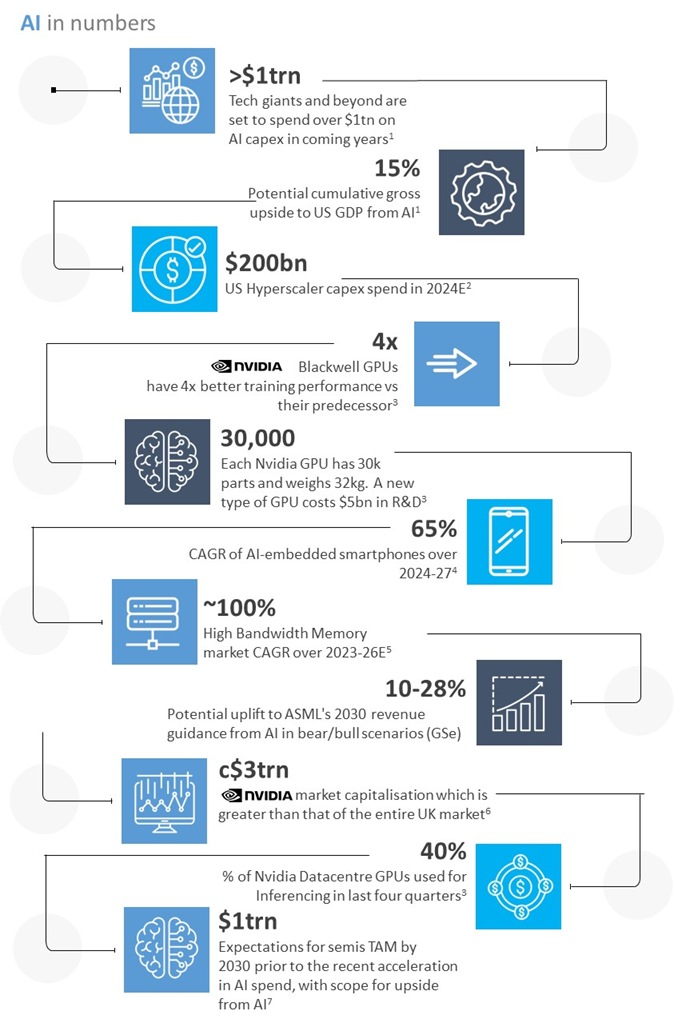August 8, 2024

As companies explore new generative artificial intelligence technologies, immense spending on the infrastructure to make it possible is underway. At the same time, investors are debating the extent to which reality will keep pace with the extraordinary hopes for AI technology.
In Europe, some of that money is being spent to boost digital enablers — companies with technology vital to build the chips powering the data centers that run the AI models. Double digit boosts to longer-term earnings power for certain digital enablers in Europe are possible, with beneficiaries in Germany, France, and especially the Netherlands, according to Goldman Sachs Research.
We talked to Goldman Sachs Research analyst Alexander Duval about the impact of the AI buildout on the European technology ecosystem.
How is AI capital spending affecting the European technology sector?
The sheer scale of investment on the hardware side globally is clearly having an impact on a regional basis in Europe, affecting the digital enablers — the companies needed to make the AI expansion possible. We see technology giants set to spend more than a trillion dollars on AI-related capital expenditures in the coming years. And that’s starting right now.
Near-term investment levels are pretty substantial. The largest US tech companies are spending around $200 billion already this year. To put that in context, that would be equivalent to roughly a quarter of the entire European continent’s capex for all sectors. So it’s truly a phenomenal amount of money. What are they spending it on? They need to beef up their AI data centers to do the parallel processing that’s needed.
Those are US companies, though, and the semiconductor foundries themselves are often in Taiwan and Korea. Where do European companies fit in?
Two specific angles. First, semiconductor equipment. If you want to make semiconductors that are this powerful, you need to buy lithography machines that can print the detailed circuitry onto the chip. There’s basically only one place you can go for these extreme ultraviolet (EUV) lithography machines: You can only get them from ASML in the Netherlands.
Beyond that, there are things like atomic layer deposition, a very precise way of putting materials onto wafers to build up transistors, and another company in the Netherlands does that. For all of these players, we are talking about a pretty substantial boost. Another company in this country is a leader in hybrid bonding, which is needed to make AI chips more power- and heat-efficient. All this stuff from an infrastructure perspective is kicking off already.

1. Link; 2. Based on our US team’s forecasts for US Hyperscalers; 3. Nvidia, 4. BESI, 5. Link; 6. Reuters, 7. ASML Source: Compiled by Goldman Sachs Global Investment Research
What other technologies or companies may get a boost?
Another aspect is the amount of power that’s required to run the AI infrastructure. That’s a major issue. A German company produces semiconductors that regulate the flow of power into the data centers, and they have some quite innovative solutions to help with efficiency. Equally we see a need for extra sensors and microcontrollers at the edge of the network, which can be supplied by French technology.
More generally, what are you watching for in terms of AI technology?
The challenge, if we think more broadly about AI, is that we don’t exactly know how the contact-with-reality scenario will play out. We don’t know what issues it may bring up. There might need to be regulation; there probably needs to be guardrails put around it. That’s more about the application of the technology and how we program the software, as opposed to issues with the hardware per se.
What potential use cases are you watching?
You can already envisage how a lot of this could be used. If you can distill the sum total of the internet into a bunch of vectors, you can basically do that for anything. You can do this for music. You can do this for proteins, so you could use AI for protein engineering. You could do this for enzymes. You could ensure that certain crops will grow better. You could generate healthcare solutions. There definitely are things that, with a bit of imagination, could be pretty interesting and easy to access.
Further work is clearly required, but clearly there are enterprises looking at ways of leveraging AI to control cost in multiple domains.
How will the best uses be sorted out?
Investors are keen to see that there is a return. Some companies have a sensible plan as to what can be done with this technology and a clear idea about how they will get a return on investment. I think investors are happy with that. Some other companies have just said they’re spending money on AI, up to several billion dollars, and the stocks have been selling off.
We caution in the report that we need to ensure that these use cases are coming through.
Your report cites the potential for a trillion dollars of investment. What is the timeframe?
Over the next handful of years, I would say. The $200 billion this year is supposed to actually go up. It’s not one-off for this year. Obviously, we have to see how these use cases take off. Can we really engineer proteins? Can we really use AI to advance carbon capture? Can enterprises truly leverage it to save meaningful cost or drive substantial productivity gains?
Several semiconductor players are forecasting extraordinary AI-related revenue growth and by implication extremely large capex plans. Clearly some of the most important technologists on the planet are of the view that this is something which has got a lot of momentum for the next few years. But in our report, we look out to 2030. If we don’t see the return on investment in that timeframe, that could suggest a more bearish scenario.
How does that affect the outlook for European chip companies overall?
We have constructed long-term scenarios for a slate of European companies. For a number of them, we can see a double-digit boost to long-term earnings — certainly for some of the semiconductor equipment names. Again, that assumes some of the more positive scenarios for AI adoption. There is going to be a need for a lot more parallel processing, a lot more high-bandwidth memory. And a lot of these equipment players here in Europe are indispensable in that arena.
